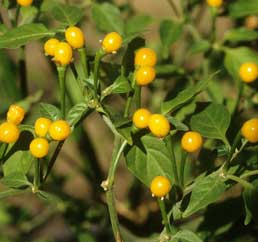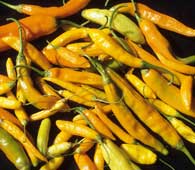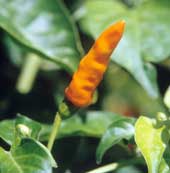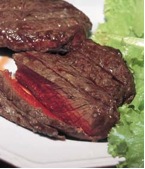By Dave DeWitt and Nancy Gerlach
“The Meating Place of Spice and Smoke”
The first outdoor cook to use chile peppers during a barbecue was Jaguar Claw, a somewhat hen-pecked paleo-Native American who lived in the Amazon Basin about 20,000 years ago. He had dispatched his prey with his spear, had butchered the world’s largest rodent with his new flint carving knife into chunks, and was contemplating boiling them for dinner.
“Boiled water pig is boring, you lazy jungle slob.” said Macaw Feather, his lovely (but rather high-maintenance) wife. “Rub the meat with this powder and then grill it on sticks over the fire.”
“What is this red powder?” asked Jaguar Claw. He had learned to be suspicious of his wife’s culinary experimentation. He still remembered the visions from those strange mushrooms she had made him eat.
“It’s made from bird berries,” answered Macaw Feather. “The birds eat them. They are hot to the taste and will flavor the meat. If the birds will eat them, they won’t hurt you.”
Jaguar Claw grudgingly followed Macaw Feather’s instructions and rubbed the meat with the red powder and let it sit for a while. Then he skewered it on thin sticks and held it above the fire until it was cooked medium rare.
Later, as the stuffed couple passed around the intensely flavored grilled meat to the rest of the tribe in the jungle clearing, Jaguar Claw asked: “What shall we call this food?”
“I’m calling them Chile-Rubbed Grilled Capybara Kabobs,” Macaw Feather stated proudly.
Well, it could have happened that way.
There is no doubt that the collision of chiles and barbecue first happened in South America, the ancestral birthplace of the wild chiles that were the precursors to the hundreds of domesticated varieties we cook with today. First used as tolerated weeds, they became an indispensable seasoning and vegetable when the advent of agriculture changed the way humans acquired food. And after Columbus brought chile seeds back to the Old World, chiles would become a part of the outdoor cooking traditions all over the world.
The recipes that follow illustrate the use of chiles in their myriad forms when combined with meat, heat, and smoke. Don’t be worried if you cannot find a certain chile—we’ve suggested substitutes for the more unusual varieties. And often you can make meat substitutions too, such as lamb for beef, or one type of game for another. We’ll start with recipes from South America, then move on to explore the blending of peppers, meat, and smoke in other parts of the globe.
A note on pork. When Nancy and I were growing up, our parents a continent apart drilled into our heads that pork had to be cooked to well done to avoid the roundworm known as Trichinosis spiralis. A lot has changed since then. Pigs are no longer fed garbage, so trichinosis has been virtually eliminated from pigs in the United States. And besides, a temperature of 140 degrees F. was enough to kill the worm, so why cook the pork to 180 degrees? The National Pork Council now recommends cooking pork to 160 degrees F., or medium but still juicy. We concur.
|
|
|
|
| The wild Brazilian bird pepper, thought to be the progenitor of the chinense species | Aji Amarillo pods, Capsicum baccatum, native to Brazil. Photos by Dave DeWitt. | Malagueta pepper, Capsicum frutescens. |
Argentinian Parrilla with Chimichurri Sauce
Photo by Rick Browne
A parrilla is a simple grill in Argentina, but the wonders it can create! As barbecue expert Steven Raichlen noted, “Argentina can be a forbidding place for a vegetarian.” Chimichurri is the sauce most commonly served with beef straight from the parrilla, and there are dozens—if not hundreds—of variations of it, and a debate about whether it should contain chiles. You know which side we favor, and our version of chimichurri contains green ají chiles. Since cattle are so large in Argentina, why not use a huge steak? Serve with grilled sweet potato and poblano chile kabobs, and black beans and rice.
Steak Rub
2 tablespoons ground red ají chile or substitute ground New Mexican red chile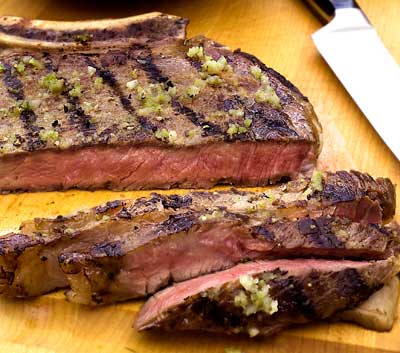
1 teaspoon dried oregano
1 teaspoon sugar
¼ teaspoon ground cumin
½ teaspoon salt
The Steak
3-pound sirloin steak, 2 inches thick
Chimichurri Sauce
¼ cup red wine vinegar
4 cloves garlic, chopped
3 green ají amarillo chiles, seeds removed, chopped, or substitute jalapeños
1 bay leaf, center rib removed
1 small onion, finely chopped
3⁄4 cup chopped fresh parsley
¼ cup chopped fresh oregano or 2 tablespoons dried
½ teaspoon salt
1 teaspoon freshly ground black pepper
¼ to 1⁄3 cup olive oil
Combine all the ingredients for the steak rub. Rub well into the steak, place in a large plastic zip bag and marinate in the refrigerator for a couple of hours or preferably overnight.
To make the sauce, combine the vinegar, garlic, jalapeños, and bay leaf in a food processor or blender and process until smooth. Add the onion, parsley, oregano, salt and pepper and pulse until blended but not pureed. Whisk in the oil and allow to sit for a couple hours to blend the flavors.
Before grilling, remove the meat from the refrigerator and bring to room temperature.
Grill the steak over a medium hot fire for about 20 minutes, turning often for medium-rare (150 degrees F. internal temperature). Remove the steak from the grill, allow to sit for 5 minutes, then slice the meat against the grain and arrange on a serving platter. Ladle some of the chimichurri sauce over the meat and serve the remainder on the side.
Yield: 4 to 6 servings
Heat Scale: Medium
Brazilian Churrasco with Molho Campanha
Photo by Rick Browne
Restaurants in Brazil called churrascarias sell spit-roasted meats to order, and the skewers the meat is grilled on are actually swords. A churrasco is simply a Brazilian mixed barbecue, featuring beef and pork—but feel free to throw in a few sausages, as that’s the way it’s done in Brazil. Molho Campanha is the Brazilian version of the Mexican pico de gallo salsa. It’s best to prepare it fresh, as it doesn’t keep well. This is a lot of food, great for a small party, but if you’re not serving the starving masses, just grill one of the meats. The malagueta chile used in the first basting sauce is a relative of the tabasco chile and is a favorite in Brazil. As for the chile in the pork basting sauce, many habanero relatives grow in the Amazon Basin, where the species was domesticated.
Note: this recipe requires advance preparation.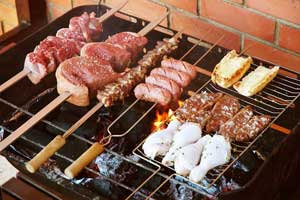
Malagueta Basting Sauce for Steak
½ cup vinegar
½ cup lime juice
½ cup red wine
6 fresh malagueta chiles, chopped, or substitute tabascos
or serranos
1 small onion, finely chopped
2 cloves garlic, minced
1 tablespoon sugar
1 tablespoon chopped fresh oregano or 1 teaspoon dried oregano
1 teaspoon dried thyme
1 teaspoon salt
Freshly ground black pepper
1 Two-pound T-bone steak, 1 inch thick
Place all the ingredients for the basting sauce in a blender or food processor and puree. Transfer to a nonreactive bowl and allow to sit for a couple hours to blend the flavors. Marinate the steak in the mixture for 1 to 2 hours.
Habanero Basting Sauce for Pork Chops
4 boneless loin pork chops
1 cup water
½ cup sugar
2 tablespoons salt
6 juniper berries, bruised (lightly bashed all over with a spoon)
2 fresh habanero chiles, seeds and stems removed, chopped
1 teaspoon freshly ground white peppercorns
1 teaspoon freshly ground black peppercorns
1 teaspoon freshly ground coriander seeds
3 bay leaves, crushed
4 whole cloves
1 teaspoon dried thyme
Place the pork into a non-reactive bowl. Combine the water, salt, and sugar in a bowl and stir until dissolved. Add the
remaining ingredients and mix well. Pour the marinade over the pork and add additional water to cover the pork, if necessary. Cover and marinate in the refrigerator overnight.
Molho Campanha Salsa
2 tomatoes, coarsely chopped
1 large onion, finely chopped
1 small bell pepper, stem and seeds removed, coarsely chopped
½ cup red wine vinegar
3 to 4 dried malagueta peppers, crushed or substitute pequin
1 teaspoon chopped fresh cilantro
Combine all the ingredients for the molho salsa and place in a serving bowl.
Bring all the meats to room temperature and make the molho campanha. To prepare the beef, drain the meat and reserve the marinade in a pan. Bring the marinade to a boil, reduce the heat and simmer 20 minutes. To prepare the pork, remove from the marinade and place on a plate. Discard the marinade.
If adding sausages to the churrasco, pierce them lightly with a fork and place on the grill away from direct flames about 10 minutes before adding the rest of the meat. Grill the beef over a medium-hot fire, basting frequently with the marinade, and turning often, for about 10 to 12 minutes for medium rare (150 degrees F. internal temperature).
Grill the pork for about 10 to 12 minutes, turning occasionally, until done to 160 degrees F.
Remove all meats from the grill and allow to sit for 5 minutes. To serve, slice the steaks against the grain in thin strips and place on a large serving platter. Arrange the pork and sausages on the platter and serve with the molho campanha.
Yield: 6 to 8 servings
Heat Scale: Medium
Armenian Lamb Brochettes on Nutty Rice Pilaf
Photo by Wes Naman
No matter how you spell it—shisk kabob or sis kebabi—this robust specialty features skewered chunks of meat and onions marinated in oil and spices and then grilled over an open flame. The technique apparently originated in the Caucasus and then spread southward to Mediterranean countries. The traditional meat has always been leg of lamb, a meat that seems to be permitted by most major religions. To make a perfect kabob, remove any tough membrane from the meat, cut meat across the grain—and don’t forget that the meat must be marinated before grilling. Serve with a salad of tossed greens, ripe olives, and feta cheese and for dessert, baklava and Turkish coffee.
Cayenne-Infused Meat Marinade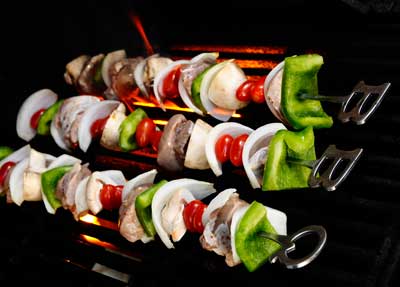
1 teaspoon cumin seeds
1⁄3 cup olive oil
2 tablespoons lemon juice, fresh preferred
1 tablespoon soy sauce
2 tablespoons dry sherry
1 cup finely chopped onion
3 tablespoons finely chopped parsley
1 tablespoon finely chopped ginger
2 cloves garlic, minced
2 teaspoons ground cayenne chile
1 teaspoon ground paprika
2 teaspoons fresh oregano
½ teaspoon cinnamon
Freshly ground black pepper
The Brochettes
1½ pounds boneless lamb, cut into 1 to1½-inch cubes,
or substitute capybara
1 large bell pepper, stem and seeds removed,
cut in1½-inch squares
1 small onion, cut in 1½-inch squares
12 cherry tomatoes
12 cremini mushrooms, stems removed
Nutty Rice Pilaf
1⁄8 teaspoon saffron
2 tablespoons water
3 tablespoons blanched almonds
3 tablespoons pistachio nuts
2 tablespoons olive oil
½ cup vermicelli, broken into 1-inch pieces
1 cup long-grain rice
½ teaspoon ground cayenne
2 ½ cups chicken or beef broth
2 teaspoons Cayenne-Infused Meat Marinade, above
To make the marinade, toast the cumin seeds on a dry skillet until fragrant, taking care that they don’t burn. Remove, cool and crush. Place all the ingredients for the marinade in a blender or food processor and puree until smooth. Season with salt and pepper.
Reserve 2 teaspoons of the marinade for the rice. Transfer the marinade to a bowl, add the lamb, toss well to coat. Cover and marinate overnight in the refrigerator, turning occasionally.
To make the pilaf, pour 2 tablespoons of boiling water over the saffron in a cup and let sit for 20 minutes. In a skillet, lightly fry the nuts in the oil, stirring constantly, for 2 minutes. Remove with a slotted spoon and reserve. Turn heat to low, add the vermicelli to the pan and cook, stirring constantly, until lightly browned, about 2 minutes. Add the rice and stir to coat and sauté for a couple of minutes or until the kernels are opaque, about 3 minutes.
Heat the broth along with the cayenne to boiling and pour over rice mixture. Bring back up to a boil while stirring. Reduce the heat to low, and simmer covered until the rice is done, about 20 minutes. Fluff with a fork before serving and add nuts. It also can be baked, covered in a 325 degree F. oven for 40 minutes.
To make the brochettes, blanch the bell pepper and the onions in boiling water for 2 minutes, remove, drain, and run under cold water. Remove the lamb from the marinade and place the marinade in a sauce pan and simmer for 20 minutes. Thread the meat on skewers, alternating with the pepper, onion, tomatoes and mushrooms. Brush with the reserved marinade.
Grill over a medium-hot fire until medium rare, about 15 minutes. Baste occasionally with the marinade. Cut a sample of the meat to check for doneness, and remove when a little under done.
Yield: 4 to 6 servings
Heat Scale: Medium
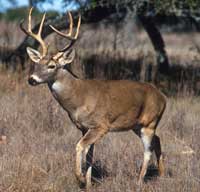 |
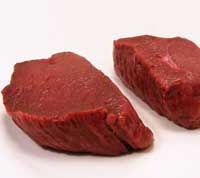 |
| Venison on the hoof. | Venison is so lean, it should be cooked medium-rare at most. |
Seared Chipotle and Garlic Venison
Game is turning up more and more in many fancy restaurants because, like venison, most of it is low in fat and has about half the calories of most cuts of beef, pork and lamb. All game available from butchers is farm raised and is not as “gamey” as wild meat. Because venison is so low in fat, often the cook needs to add additional oil or fat during the cooking. It is best cooked rare or medium-rare. If you can find it, you can substitute elk for the venison.
Smoky Chile Marinade
4 dried chipotle chiles
1 cup hot water
8 cloves garlic
½ cup chopped onion
1⁄3 cup olive oil
½ cup dry red wine
2 tablespoons red wine vinegar
2 teaspoons Dijon-style mustard
2 teaspoons brown sugar
2 teaspoons ground chile de arbol or other ground hot chiles
1 teaspoon Worcestershire sauce
The Venison
4 venison steaks or substitute beef steaks, 1 inch thick
Cover the chipotle chiles with hot water and soak for 30 minutes to soften. Drain and remove the stems and seeds from the chiles.
Sauté the garlic and onion in the oil until soften. Allow to cool. Place all the ingredients, except the venison, in a blender or food processor and puree until smooth.
Place the meat in a nonreactive pan, cover with the marinade and marinate, covered, for 2 hours in the refrigerator.
Grill over a medium fire, basting frequently with the marinade and turning often, for about 16 minutes, until rare or medium rare, internal temperature at 150 degrees F. Slice one of the steaks open to check for doneness, if you wish.
Yield: 4 servings
Heat Scale: Medium
|
|
|
| The Chimayo land race, New Mexican pod type. Pods are both erect and pendant. Photo by Dave DeWitt. | The charming village of Chimayo, New Mexico is known for spectacular red chile and for miracle healings at the Sanctuario de Chimayo. Photo courtesy NM Department of Tourism. |
Chimayó Chile Steaks with Chipotle Potatoes
From the little village of Chimayó, New Mexico comes what many chileheads consider to be the finest tasting red chile. We use it in our enchilada sauces and for making rubs such as this one. The smoky taste of the chipotle potatoes is a nice complement to the grilled steak. Serve the steak and potatoes with mixed green and yellow snap beans and jalapeño cornbread.
Chimayó Rub
2 tablespoons New Mexico ground red chile,
Chimayó preferred
1 tablespoon sugar
1 tablespoon ground cinnamon
2 teaspoons ground coriander
1 teaspoon ground cumin
1 teaspoon salt
¼ teaspoon ground thyme
Chipotle Potatoes
2 large baking potatoes
2 to 3 tablespoons milk
1 tablespoon chipotles in adobo, chopped
¼ teaspoon garlic powder
Chopped chives for garnish
Salt and freshly ground black pepper to taste
The Steaks
Olive oil
4 New York Strip steaks
Combine all the ingredients for the dry rub in a bowl.
Bake the potatoes until just done. Scoop out the potatoes and whip with the milk, chipotles, garlic, and just enough additional milk to hold them together. Place the potatoes back in the skins. Place the potatoes on the grill, away from the direct flame, and heat the grill.
When the grill is hot, brush the steaks with the olive oil and liberally coat with dry rub. Grill the steaks for about 12 to 16 minutes, turning often, for rare, 15 to 20 minutes for medium-rare (internal temperature 150 degrees F.). You can slice it open to check for doneness, too. Serve with the potatoes.
Yield: 4 servings
Heat Scale: Medium






